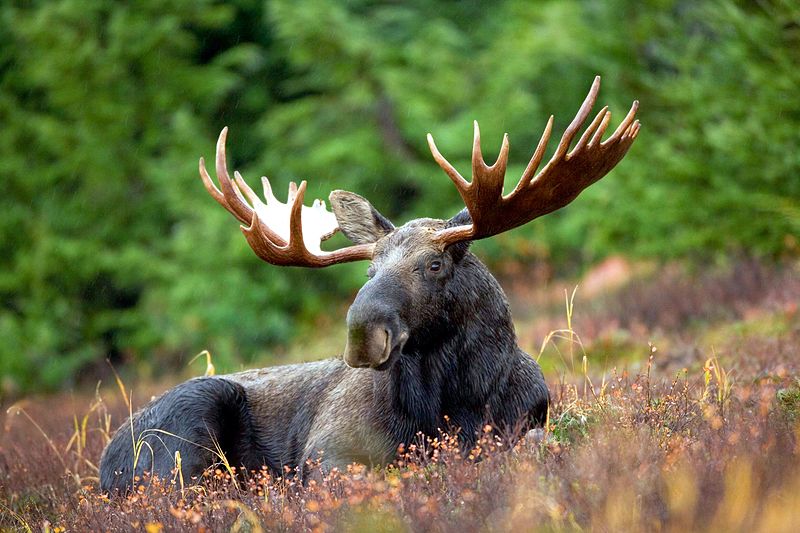Moose: monarchs of the Maine woods, but for how long?
During my 33-year career as a wildlife biologist in Maine, “Where can I see a moose?” was the most frequently asked question.
Everyone, it seems, would like to see a moose.
The large, iconic animals are “a highly charismatic, sexy species,” according to tourist guide booklets. With a statewide estimate of 76,000 moose, Maine is home to the largest moose population outside of Alaska.
Although moose can be seen near Camden (I’ve seen a bull moose twice in successive autumns on the edge of Moody Pond in Lincolnville), Midcoast Maine is not moose population central. The animals are more abundant and more easily observed from the western Maine mountains north to Aroostook County.
In Minnesota, moose populations have dropped by nearly 70 percent since 2006. In response, biologists there have canceled moose hunting season for the first time in decades.
The recent question people are asking is, “With the rapid decline of moose numbers in New Hampshire, will Maine’s moose population suffer too?”
Global warming is raising havoc with moose populations in New Hampshire, New York, Wisconsin, Minnesota and elsewhere in the northern hemisphere. But for reasons that are not entirely understood, our moose populations seem to be holding up, for now anyway.
Shorter, milder winters are detrimental to moose because they host a very troubling parasite known as winter tick. Winter ticks feed on the blood of hoofed animals, especially members of the deer family, and have been found on deer, woodland caribou, bison, horses and cattle. However, ticks reach their highest densities on moose.
Unlike deer ticks, winter ticks seem uninterested in obtaining blood meals from humans. During more “normal” snowy and cold winters, winter tick populations naturally die back. In recent years, shorter and milder winters allow ticks to survive and multiply. A 15-year-old moose that hosted a hundred ticks as a yearling now can host as many as 100,000 ticks. In New Hampshire, heavily tick-infected moose are becoming anemic from loss of blood. With compromised immune systems, the animals are more susceptible to diseases and predation.
An increasing percentage of New Hampshire’s calf moose are dying from tick infestations. Consequently, moose are disappearing by the thousands in areas where they were once fairly common. Those that survive are called “ghost moose” because their hairless skin is pale white. To dislodge ticks, moose frequently rub against trees and this causes their hair to fall out in clumps.
Moose are an excellent indicator species of how climate change is affecting wildlife populations in general. They are superbly adapted to cold weather. Their thick soft winter undercoat and dark brown outer winter coat is comprised of hollow hair shafts (trapped air provides wonderful insulation). Moose not only thrive in cold climates, increasing climate change data indicates that moose may not be able to survive without prolonged snowy and cold winters.
As global temperatures rise, moose populations are declining throughout the northern hemisphere, from Norway to Minnesota. They are big-bodied, heavy, dark animals. As such, they absorb, generate, and expel lots of heat. While calves begin to feel the cold at -22 F, adults are able to withstand far colder temperatures.
Moose are so well insulated from the cold that winter temperatures of 23 F will make them pant. When winter temperatures rise above the mid-20s, moose require the shade of softwood (evergreen) cover to remain cool. On warm winter days above 32 F, some moose will lie flat in the snow to try to dissipate their body heat. Summer temperatures as low as 57 F can cause moose to begin to suffer from heat stress, and moose will begin panting at 68 F.
Having no knowledge of where to go, Maine moose won't migrate north to Canada as global temperatures increase. They will stay in their home range and attempt to adjust by spending more time in the shade or cooling in ponds or climbing to higher elevations. The stress of high summer temperatures causes moose to stop eating. This in turn leaves them more vulnerable to winter starvation because they are unable to accumulate summer fat deposits needed to survive Maine winters.
Cow moose that enter the winter in poor health are more likely to suffer poor reproductive success during the spring calving season. Pregnant cows in poor health have been known to absorb their fetus, deliver stillborn calves or give birth to calves that are too weak to stand and suckle. In the Northeast, the trend of increasing temperatures and milder winters does not bode well for moose populations. Studies in New Hampshire indicate that winter moose with blood-draining ticks also suffer from brainworms, lungworms and diseases exacerbated by climate change-induced physical stress.
In Minnesota, moose populations have dropped by nearly 70 percent since 2006. In response, biologists there have canceled moose hunting season for the first time in decades. Minnesota researchers have also found that rising temperatures correlate to higher moose mortality rates.
Maine biologists are closely monitoring the health of the state’s moose population given the disturbing downward trends elsewhere.
There is no end to the ripple effect of climate change, even for a single iconic species that has survived largely unchanged for a half-million years.

























